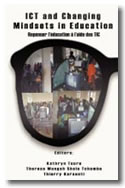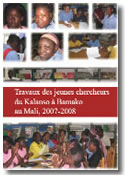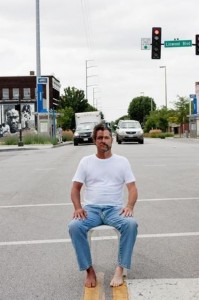The art of provocation: Kansas City artist A. Bitterman takes a fresh look at old problems March 17, 2014
By ALICE THORSON
The Kansas City Star
For the better part of a decade, Kansas City artist A. Bitterman has been perplexing and provoking local art-watchers, mounting a giant banana on the side of the Folly Theater, posing nude for aerial photographs on the roof of his Armour Hills home and pointing a gun at the city’s iconic “Scout” statue in Penn Valley Park.
Bitterman’s images and objects rarely function as conventional gallery art. For him, art is a tool of disruption. His targets are outworn ideas, powerful institutions and conventional responses to social issues and problems.
“He’s really thoughtful in what he’s doing” said Nelson-Atkins Museum of Art CEO/director Julian Zugazagoitia. “He knows how to create a spark. There’s also a feeling of someone who is very free, not linked to any of the systems. I think he is anti-institutional to a degree — that is the edge he has and doesn’t want to relinquish. All of his practice has evolved around that, and that’s very commendable.”
Zugazagoitia, who came to the Nelson in 2010, experienced Bitterman’s tactics early in his tenure, when a package from the artist arrived at the museum.
“It was a big package with two cardboards wrapped with recycled world maps, mysteriously dropped at security,” he recalled. “We opened it, and there were these pictures.”
The pictures were photographs of the Bloch Building emblazoned with a huge Wal-Mart logo. It was placed there during a guerrilla installation, “A. Bitterman vs. Steven Holl,” that Bitterman had staged at the museum with a group of friends in June 2010.
“I wanted to brand the building,” Bitterman said in a recent interview. He downloaded the letters for the Wal-Mart sign and cut them out of masonite.
Then, he mounted the individual letters on a PVC pipe structure fitted with lifting poles that enabled him to position the letters against the building with the help of multiple friends. At 8 a.m. on a Sunday, they hoisted the letters, and Bitterman had Lawrence photographer Jon Blumb record the event.
They group did three sections of the Bloch Building, he said: “We didn’t Photoshop. The whole thing is to actually do it.”
The installation proceeded without interference, he said, until the participants congregated at the entrance for a final group photograph. Security officers showed up and wanted to know if the group was with Wal-Mart.
“They thought it was an ad shoot or that we were up to no good,” Bitterman said.
Two months later, when the photos arrived on his desk, Zugazagoitia puzzled over what to do with them. He decided to bring them to the next full curatorial meeting.
“We had the best discussion about whether a work like this should enter our collection and its merits — whether it was an artistic piece or documentation,” he said. “Many times we acquire works of great value and the discussion lasts a second. We spent two hours on this, and after a long debate, decided it should enter our research library because it is questioning our building.
“He is recognizing the institution,” Zugazagoitia added. “That same piece performed on a nondescript building doesn’t have the same edge. It’s similar to the conversation he generated with the billboards.”
Re-viewing ‘The Scout’
Bitterman’s most provocative piece to date was the pair of billboards he installed last fall at 19th Street and Baltimore Avenue. One showed a view of downtown and carried the cheery message “Discover Kansas City.” The other featured an image of Bitterman on a scaffold aiming a gun at the city’s “The Scout” sculpture of an Indian on horseback, created in 1922.
Within days the billboards came down amid charges of racism.
“I didn’t know what was going to happen,” Bitterman said. “My biggest fear was apathy.”
The piece drew strong reactions even before it was mounted.
In fall 2012, the work was accepted by the Missouri Bank’s Crossroads Artboards program. The following July, the bank had a change of heart about sponsoring the work and told Bitterman it would not be installed.
In response, Bitterman put out a press release, challenging the bank’s motives and the integrity of the program.
He also began discussions with CBS Outdoor to rent two billboards across the street from the bank. Following a lot of back and forth, the company and the artist reached a “handshake agreement” that if the work caused too much trouble, he would take it down.
The piece went up Sept. 23 and was removed Sept. 30, following objections from Moses Brings Plenty, community outreach coordinator with the Kansas City Indian Center and a member of the Oglala Lakota nation.
In 1929, Rene Magritte, the Belgian surrealist, painted an image of a pipe on a white background and included an inscription below it: “Ceci n’est pas une pipe.” (This is not a pipe.”)
Bitterman’s work turns on the same distinction between an image and the thing it portrays.
“I’m not shooting at an Indian; I’m shooting at a white narrative of an Indian,” he said.
When it comes to advertising, people rarely take images at face value, knowing they are designed to persuade. But this awareness is not as common when it comes to historical art.
“The Scout,” Bitterman notes, is a “white cultural imagining of an Indian, made within 20 years or less of the final push of genocide.”
“A lot of the ideas we have are inherited from another time and become ossified,” he observed. “I’m interested in unpacking these inherited stories.”
Yet many Americans are resistant to overturning inherited ideas about the nation’s western expansion and to approaching artworks as carriers of agendas.
A prime example was the public outcry that greeted the 1991 exhibit “The West as America: Reinterpreting Images of the Frontier, 1820-1920” at the Smithsonian’s American Art Museum. The controversy over the show’s revisionist look at popular historical images reached all the way to Congress.
Two weeks after Bitterman’s billboards came down, the artist and Moses Brings Plenty engaged in a public discussion about the piece at a local artists venue.
“He started speaking Lakota and addressed the suffering of his people,” Bitterman said. “As a person of white culture, I’m part of the hegemony. What could I possibly say to him that would mean anything? The magnitude of the offense is still incomprehensible. What do I have to answer that? Shame. That’s what the work pivots on.”
Bitterman still wonders what the impact would have been had Moses Brings Plenty backed up his effort to unmask a “romantic white culture conception” that ignores the magnitude of the offense.
Yet he understands why his project may appear as just another white guy attempt to control the American Indian message.
“Moses did what he had to do to control the message of a historically subjugated group,” he said.
For Bitterman, the dialogue surrounding the work is an essential part of it.
“He’s thinking on a very different plane (about how) to make people question and think,” said John O’Brien, former owner of Dolphin gallery, who recently opened Hammer Out Design. “I think he’s a very bright guy.”
“I believed in that (billboard) piece,” O’Brien added. “I think we’re beyond the point in this city of trying to sugarcoat anything. If we’re going to move forward, we have to be honest. Disagreements can be a good thing if it comes from a passionate, honest point of view, and Pete’s an honest maker.”
“Pete” is Pete Cowdin, A. Bitterman’s given name. The father of five came up with A. Bitterman as a way to keep his activities as an artist separate from his non-art pursuits.
Naked on the roof
Trained as a printmaker at Carleton College in Northfield, Minn., where he earned his bachelor’s degree in 1985, Bitterman enrolled in and was expelled from the graduate printmaking program at Michigan’s Cranbrook Academy of Art in 1987. His offense? Transforming a pricey school cafeteria chair designed by Eliel Saarinen into a sculpture.
The following year he moved to Kansas City with his wife-to-be, Debbie Pettid, founder of the Reading Reptile children’s bookstore. In the early 1990s, Bitterman worked on his master’s degree in urban environmental geology at the University of Missouri-Kansas City, continuing a long hiatus from artmaking that ended with his decision to apply to the 2006 Avenue of the Arts.
In collaboration with Pettid, he proposed a giant papier-mache banana for the side of the Folly Theater.
“It was a shock we got (the commission) to begin with,” he said, comparing the logistics of installing the work in accordance with strict safety standards to the effort to transport a steamship overland in the 1982 movie “Fitzcarraldo.”
Despite the difficulties with the banana project, Bitterman succumbed to the art bug, conceptualizing a new piece that involved finding an aerial photographer to capture him nude on the sloping roof of his Armour Hills home.
“The roof piece took two years,” he said. “I started out calling aerial photography companies. They hung up when I said, ‘I’m going to be naked on my roof and want photos.’ ”
Then he found Blumb, who had worked with William S. Burroughs and was a student pilot.
“On a spring morning, he flew a prop plane over and did a bunch of flybys. The piece went dormant for a while, and we shot it again and made an animation.”
“Lot 18,” an exhibit featuring the film, aerial photos and a rooftop installation, opened in June 2011 at the Subterranean Gallery in Southmoreland.
Bitterman’s artist statement for the exhibit casts it as a response to the romanticism of macho 1960s earth artists and their work in remote locations: “Cities hide the sky and keep us focused on the little things. I take off my clothes, climb to the roof and stake my claim between earth and sky.”
“No pick, no shovel,” he added, in a veiled bid for the cerebral side of art.
But the work also carries a visceral charge, with the artist’s naked body serving as a personification of human vulnerability.
And it subverts. Bitterman’s splayed pose, reminiscent of Leonardo da Vinci’s Vitruvian Man, conveys resistance to the convention and standardization implicit in the Renaissance artist’s canon of ideal human proportions. It can also be read as a gesture of resistance to the pleasant, tree-shaded neighborhood that surrounds him.
“Hopes, dreams, pain, suffering, boredom, death, trees,” he intones over and over in the accompanying soundtrack. The underlying theme of the work may be the obvious one: escape.
“We’ve given ourselves away to technology,” he said. “We’re in an eternal state of distraction. Our capacity to ignore things has been elevated. We have a high threshold to tolerate the intolerable.”
Bitterman aims to cut through this distraction by any means necessary. His actions and images protest the inefficacy of liberal orthodoxy to effect change or solve society’s big problems, from the environment to race.
“We’re all asked to recycle our plastic bags,” he remarked. “Our relationship with the environment isn’t going to change. We as individuals are expected to make up for 150 years of corporate malfeasance. That’s never not going to happen. So how do we deal with it in a way that is responsible?”
Reframing the issues
One of Bitterman’s pet peeves is our conception of wild nature, “a place that seems truly beyond our reach … we go to great lengths to preserve it, mediate it and in many cases re-create it.”
In the summer of 2012, he landed a summer residency at the Indianapolis Museum of Art, where he spent his days in the museum’s adjacent Virginia B. Fairbanks Art & Nature Park: 100 Acres, playing the role of one of the park’s “natural” attractions.
For his project, “Indigenous: Out of the Wild,” Bitterman devised a system of hand gestures to interact with visitors that he demonstrated on a hilarious video posted on the museum’s website.
People could also track his whereabouts via a GPS tracker and feed him nuts from a “feed the artist station” he designed. His installations throughout the park included viewing scopes, a wood kiosk patterned after those found in national parks and a large cage outfitted with an easy chair and other comforts.
“Indigenous” picked up from an earlier project, “Point of Interest,” in which Bitterman turned his yard into a national park. With funding from an Andy Warhol Foundation Rocket Grant (administered by Kansas City’s Charlotte Street Foundation and the Spencer Museum of Art in Lawrence), he marked out trails, constructed an elaborate information kiosk, designated a picnic area and gave visitors an opportunity to apply for backcountry permits.
Lately, Bitterman has been spending a lot of time thinking about Troost Avenue and all the failed efforts to overcome the inequities of black and white, east and west.
“We see Troost as a problem, but it’s a symptom of a problem,” he said. He asked himself, What if the city was segregated, but it was me?
That question is the basis for a film in progress, “Half Life.” As he writes in his synopsis: “Haunted by a city that seems permanently divided, the artist wakes up on a bus to find himself transformed — half black, half white — a personification of the city itself. An existential crisis unfolds.”
Bitterman knows he may take criticism for assuming a half-black identity in the film, but he is undeterred.
“I’m going to approach things from where I am, not where I should have been,” he said. “There are a lot of problems in art, politics and society that we approach with sympathy.
“Sympathy doesn’t change perceptions. It reinforces them,” he insists. “I can sympathize: Can I create something to change the way people see those things?”
Critic and scholar Claire Bishop makes a case for the importance of art that may initially seem “uncomfortable, exploitative or confusing” as it attempts “to confront darker, more painfully complicated considerations of our predicament.”
Bitterman has been following her work, including her new book, “Artificial Hells: Participatory Art and the Politics of Spectatorship,” in which Bishop argues against self-censorship based on “second-guessing how others will think and respond.”
“The upshot,” she writes, “is that idiosyncratic or controversial ideas are subdued and normalized …”
“I would argue,” she continues, “that unease, discomfort or frustration — along with fear, contradiction, exhilaration, and absurdity — can be crucial to any work’s artistic impact.”
Many of those words apply to Bitterman’s “City of Fountains” project, a collection of postcards illustrating his proposal to move a condemned house from the city’s East Side to the Sculpture Park at the Nelson and to transfer Henry Moore’s “Sheep Piece” to the vacated house site at 4934 Chestnut Ave.
Bitterman characterizes his playfulness with the museum — which includes a session when he donned a loincloth and stood on Walter De Maria’s golden platform in the reflecting pool — as an expression of the artist’s dilemma: “I wanna get in. I don’t wanna get in.”
But the institution also represents an important arbiter and player in the myths and realities he confronts in his work, from romanticized nature and corporate power, to the divided city and the legacy of white cultural dominance.
In coming months, Bitterman will install an image on the ARTwall on the Town Pavilion Parking Garage at 13th Street and Grand Boulevard. Selected by the Municipal Arts Commission and Art-in-the-Loop Foundation, it’s a photograph that captures the portion of the garage that the billboard-sized ARTWall covers. Once in place, the image will offer a seamless view of the garage, in essence making the ARTwall disappear.
He also has another foray at the Nelson-Atkins planned:
“I’m going to bury a headstone in the lawn of the museum: Here lie the best ideas of A. Bitterman 1963-2013.”
To reach Alice Thorson, call +1-816-234-4783 or send email to athorson@kcstar.com.
Source: www.kansascity.com/2014/03/14/4887420/the-art-of-provocation-kansas.html




Leave a Reply